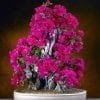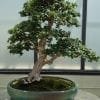The Himalayan cedar bonsai is a dwarf variant of the Himalayan Cedar. The bonsai variety of this tree was first cultivated in Australia. The tree sports light green needles with rich golden undertones and the oils in its bark produce a wonderful aromatic scent.
When properly pruned and cared for, the Himalayan bonsai cedar grows between four to six inches a year. If it is not regularly trimmed, however, the tree can grow as high as 15 inches. Its typical shape is conical shape.
Himalayan cedar bonsai trees make beautiful additions to outside gardens in zones 6 through 9, the central and southern temperature zones of the United States, and wonderful indoor plants in colder regions.
They can also be taken out in the warmer months, and brought back inside during the colder seasons. Outdoor trees will frequently develop a beautiful carpet of green moss on the surface of their soil.
| Scientific/Botanical Name | Cedrus deodara |
| Description | Himalayan cedars are indigenous to the western slopes of the Himalayan Mountains. They are evergreen trees, with short leaves that are like pine needles. The leaves grow in clusters along the length of each branch. When the trees are grown in full sun, the needles are light-green in color, but when the trees are grown in part-shade, the leaves exhibit a darker, more natural blue hue. The Himalayan cedar bonsai is capable of growing up to six inches in one year, and if it is not trimmed on a regular basis it will attain a height of 15 inches. |
| Position | Himalayan cedar bonsai trees will not tolerate smoggy environments. In areas where smog and other atmospheric pollutants exist, the plants are best grown indoors. Ideally, the trees should be grown is locations that enjoy morning sunlight and afternoon shade, especially during the heat of late-spring and summer. Sheltered locations add a further level of protection that benefits the vulnerable tree branches. |
| Watering | The plants require just a moderate amount of water during warm conditions, and only a small amount of water during the cold months. Allow the soil to dry out before each watering. Excessive moisture will cause discolored needles, needle cast and root rot. |
| Feeding | For optimal growth, fertilizer should be applied to the soil on a regular basis. The fertilizer should be water-soluble, and it should be applied to loose, damp soil for proper penetration to the roots. A bonsai nurseryman will be able to give advice on the most appropriate brand of fertilizer. |
| Leaf and Branch Pruning | Cedars are easily pruned for shaping. They are particularly well-suited to cascade, semi-cascade or informal upright styling. Pruning the tree trunk is important, and should be undertaken when the tree is young. The trunk should be pruned so that it is thickest at the base, but tapered toward the leaves. |
| Re-potting & Growing Medium | Cedar tree roots require ample room to grow, so they may need re-potting each year. Early springtime is the ideal time for re-potting. The most beneficial soil will consist of 35 percent organic matter such as composted tree back, and 65 percent aggregates, such as coarse sand or pumice and decomposed granite. |
| Wiring | The Himalayan cedar tree is rich in natural oils. As such, wiring the tree is not recommended. Pruning the tree is a much more suitable method of shaping. |
| Notes | Cedar tree trunks will not become thicker when the trees are grown in containers. They should be grown in the ground to develop thick trunks. Cedar wood is pleasingly aromatic: The fragrance stems from the oils contained in the bark of the tree. The bark, wood and oils from the tree are renowned for their medicinal and anti-inflammatory properties. |
About Himalayan Cedars
Himalayan cedars are natives of the Himalayas’ western slope. The tree is worshipped as divine among Hindus. The scientific name for the tree, Cedrus deodara, is derived from a Sanskrit term “devadaru” that literally means “wood of the gods”.
The Deodar tree has been prized for centuries for the durability of its wood and the curative properties of its wood, bark and oils, which contain anti-inflammatory chemicals.
Traditional Indian Ayurvedic medicine recommends using preparations made from the Deodar tree in the treatment of fevers, diarrhea and skin conditions.
Care
Bonsai Himalayan cedars require less maintenance than many other types of bonsais, and can be trained to grow in a variety of different shapes and styles. These two properties make it an ideal plant for those who are new to growing and caring for bonsai trees.
Make sure that your starter tree has bare roots but is still sufficiently anchored in its container soil. This tree does not do well in smoggy conditions. If you live somewhere with a high air pollution index, the tree may do better as an indoor plant.
Optimal Location
The optimal place in your garden for a bonsai Himalayan cedar is an area that catches the morning sun but is shaded during the hottest parts of spring and summer days.
The same guidelines hold true for indoor plants. The tree’s branches are also susceptible to damage when extreme weather prevails, so the tree needs to be placed in a relatively protected spot.
Water
Bonsai Himalayan cedars don’t need very much water. In fact, excessive watering can lead to root rot and discoloration of the needles. Water moderately during the warmer months, and very little during the colder months. Wait until the soil around the plant has dried out before watering.
Soil
Bonsai Himalayan cedars thrive in a variety of different types of soils so long as that soil is well-drained. The tree has no preferred pH range and will tolerate acid and alkaline soil mixtures equally well.
In its natural habitat, the Deodar cedar grows in soil with a high concentration of granite, so some bonsai experts recommend a soil mixture with a high concentration of aggregates as well as organics. The aggregates should include decomposed granite and coarse sand or pumice.
Fertilizer
Like many other bonsais, the bonsai Himalayan cedar does best if it’s fertilized regularly. Speak to your nursery professional to find out which fertilizer is right for your plant. Make sure that the fertilizer you buy is water soluble, and apply the fertilizer solution while the soil is wet but still loose enough to soak it up.
Training
Pot
A common mistake among inexperienced bonsai gardeners is buying a pot that is wrong for their plant. Immature bonsai trees often do best in pots that may seem too big for them. These pots give their roots an opportunity to grow. The ideal pot for your more mature bonsai is one that is approximately two-thirds the height of your tree.
Roots
Visible roots are an important aesthetic element in all bonsais. They’re also important because they anchor your Himalayan cedar bonsai to its soil. The side roots are the ones that grow into the most pleasing radial arrangements.
Trunks
The trunk of your Himalayan cedar bonsai should be thickest at its base, tapering upwards towards the foliage. This shape requires pruning while the tree is still young. Many bonsai gardeners prune their trees so that an auxiliary branch growing close to the soil essentially becomes the apex of the tree. Beginning bonsai gardeners are advised to consult with an experienced bonsai gardening resource before they undertake drastic pruning, however.
Branches
Auxiliary branches are the sign of a healthy, thriving bonsai. These secondary branches sprout out from the primary branches, growing lighter and lighter the further they are from the primary branch.
What you’re aiming for is a plant with thicker branches towards its bottom and thinner branches towards its top. This can only be accomplished by regular pruning.
Branches closer to the apex of the plant need to be pruned sooner than branches lower down on the plant in order to keep this characteristic shape.
Shaping
Wiring is not the best way to shape a Himalayan cedar bonsai because cedar wood has so much natural oil. Pruning is a much more effective method. The shapes that work best are those that mimic the natural shape of the full-size tree:
Informal Upright
In this classic bonsai style, the beauty of the tapered trunk and auxiliary branches is showcased. The trunk is pruned so that it grows roughly in the shape of the letter S.
Cascade
This style, in which the tree grows down out of its pot, is one of the most remarkable and harmonious of all bonsai arrangements, but is difficult to achieve because trees, like other plants, tend to grow upright.
Semi-cascade
In this style, the trunk stays above the rim of the pot, but the branches dip down as though the tree is planted by the waters of a stream.


